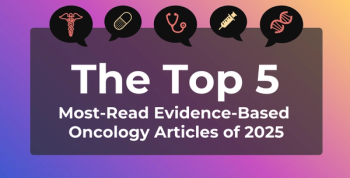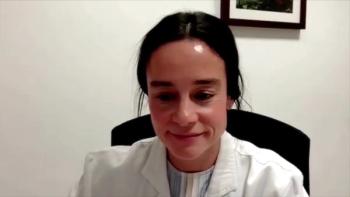
- January 2024
- Volume 30
- Issue 1
- Pages: SP54-SP55
LINKER-MM1: Updated Data Show 46% Complete Responses to Linvoseltamab at 11 Months in R/R Multiple Myeloma
Regeneron officials say they are on track to file for FDA approval for the bispecific antibody by the end of 2023.
Updated pivotal data showed the bispecific antibody linvoseltamab produced strong response rates and complete responses (CR) in nearly half the patients with heavily pretreated multiple myeloma after 11 months, and the drug’s sponsor said the results mean the company is on track to file for FDA approval by the end of 2023.1
Regeneron Pharmaceuticals announced the primary end point analysis for the phase 1/2 LINKER-MM1 trial (NCT03761108) ahead of the opening of the 65th American Society of Hematology Annual Meeting and Exposition in San Diego, California, saying the results built on the 8-month data cut presented in an abstract.1,2 Company leaders touted an objective response rate of 71%, which was the primary endpoint, and a CR or better of 46% for patients taking the 200 mg dose of linvoseltamab.1 Key secondary objectives include duration of response, progression-free survival, rate of minimal residual disease negative status and overall survival.
Linvoseltamab, an investigational BCMAxCD3 bispecific antibody, would compete with others in the class designed to bridge B-cell maturation antigen (BCMA) on multiple myeloma cells with CD3-expressing T cells, triggering the activation of T cells to target cancer.
In phase 2, LINKER-MM1 enrolled patients with multiple myeloma who had progressed after at least 3 prior lines of therapy, including a proteasome inhibitor, an immunomodulatory drug, and an anti-CD38 antibody, or were refractory to all 3 therapy classes. A protocol amendment to the trial allowed patients who had progressed on a lower dose of 50 mg during weeks 4 to 12 of the trial to escalate their dose to 200 mg. Key secondary endpoints included duration of response (DoR) and minimal residual disease status.3
“Multiple myeloma remains an incurable disease, in which patients endure cycles of relapse and remission, resulting in a critical need for innovative medicines,” L. Andres Sirulnik, MD, PhD, senior vice president, Translational and Clinical Sciences, Hematology at Regeneron, said in a statement. “With longer follow-up data on linvoseltamab, we’re seeing deep and durable responses with a complete response rate nearing 50% in a difficult-to-treat patient population who had received a median of 5 prior lines of therapy.”1
“Furthermore, in our trial, the regimen had a short monitoring time and a convenient, response-adapted administration schedule that enabled deep responders to go from every 2-week to every 4-week dosing,” Sirulnik said. “This regimen saved time for clinicians and patients, underscoring the potential for linvoseltamab as a patient-centric option in relapsed/refractory multiple myeloma.”
Results were observed in 117 patients after a minimum of 24 weeks receiving linvoseltamab. Among this group, 27% were more than 75 years of age, 16% had extramedullary plasmacytomas, 23% had bone marrow plasma cells of at least 50%, and 39% had high-risk cytogenetics. In addition, 17% of the study population was Black or African American, reflecting rates of multiple myeloma in this population in the United States.
Adverse events (AEs). By 11 months, every patient receiving the 200 mg dose or linvoseltamab had experienced an AE, and 85% had experienced an AE of grade 3 or higher. Fourteen patients had died from treatment-emergent AEs, of which 11 were due to infections; 73% of the patients had infections, and 34% were grade 3 or 4.
The most commonly occurring AE was cytokine release syndrome (CRS), seen in 46% of patients, with most of these cases grade 1 (35%); 10% were grade 2 and 1 case was grade 3. There were 9 patients with immune effector cell-associated neurotoxicity syndrome (ICANS) events (8%), 3 patients had grade 3 ICANS, and no cases were grade 4 or higher.
Regeneron officials report that 282 patients have now enrolled in LINKER-MM1 and a phase 3 trial is planned.
References
1. Updated linvoseltamab pivotal data demonstrated strong rates and depth of response in patients with heavily pretreated multiple myeloma. News release. Regeneron. December 7, 2023. Accessed December 22, 2023.
2. Jagannath S, Richter J, Dhodapkar MV et al. Patterns of response to 200 mg to linvoseltamab in patients with relapsed/refractory multiple myeloma: longer follow-up of the LINKER-MM1 study. Presented at: 65th American Society of Hematology Annual Meeting and Exposition; December 9-12, 2023; San Diego, CA. Abstract 4746.
3. Lee HC, Bumma N, Richter JR, et al. LINKER-MM1 study: Linvoseltamab (REGN5458) in patients with relapsed/refractory multiple myeloma. J Clin Oncol. 2023;41(suppl_16): abstr 8006. doi:10.1200/JCO.2023.41.16_suppl.8006.
Articles in this issue
almost 2 years ago
Overcoming Barriers to Care Equity in Multiple Myelomaalmost 2 years ago
ASH 2023: Coverage in MDS, Myeloproliferative Diseasealmost 2 years ago
ASH 2023: Coverage in Multiple Myelomaalmost 2 years ago
ASH 2023: Coverage of ALLalmost 2 years ago
ASH 2023: Coverage of cHLalmost 2 years ago
ASH 2023: Coverage of MCLalmost 2 years ago
ASH 2023: Coverage of CLL/SLLalmost 2 years ago
ASH Abstracts Showcase Effective Treatments for MM, CLL, FLalmost 2 years ago
Data Reveal Racial, SDOH Factors Linked to OS Differences in CLLNewsletter
Stay ahead of policy, cost, and value—subscribe to AJMC for expert insights at the intersection of clinical care and health economics.





























































